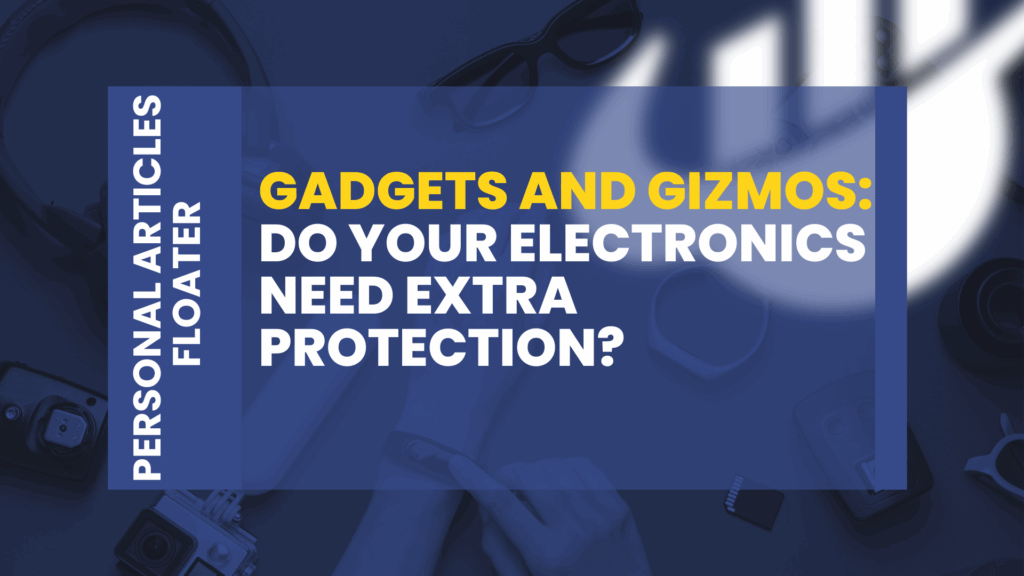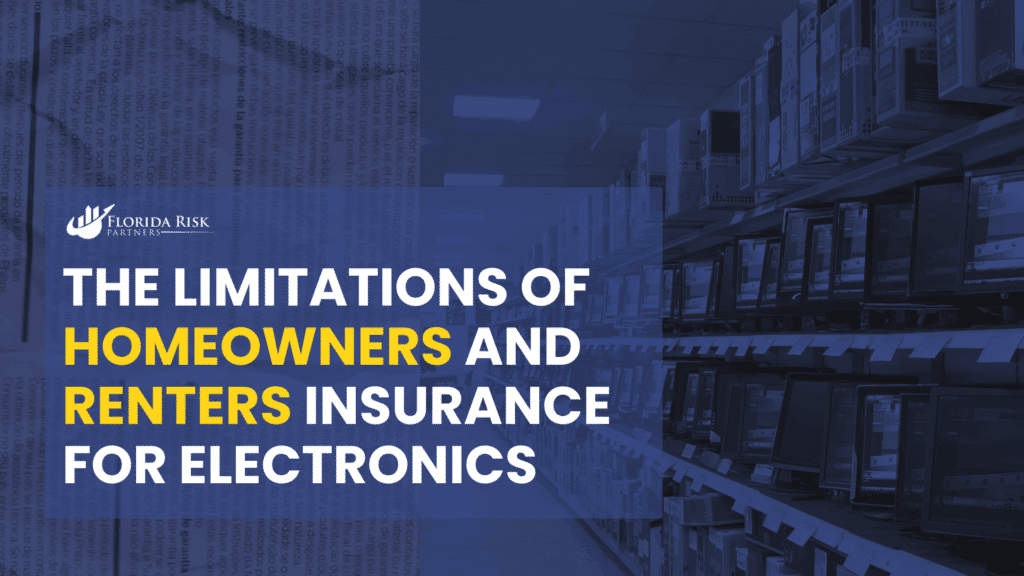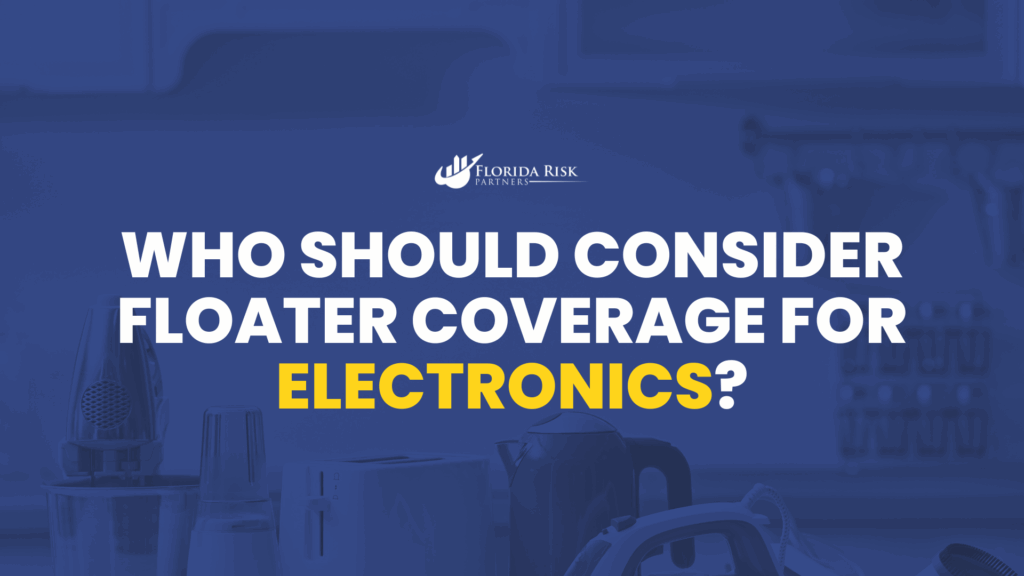-
Main Office: 1434 E. Bloomingdale Ave Valrico, FL 33596-6110
-
Phone: (888) 601-6660
-
Email: info@floridariskpartners.com

Personal electronics and smart devices have become more than just tools—they serve as our means to communicate, create, work, play, and capture memories. Moreover, the average household now owns thousands of dollars in tech gear, ranging from high-end laptops and DSLR cameras to smartwatches and drones. Despite investing heavily in these devices, most people don’t stop to consider whether they have adequate insurance coverage.
When disaster strikes—whether a cracked lens, a stolen laptop, or a drone crashing during flight—many people are shocked to discover that their homeowners or renters insurance offers minimal protection for these items. Furthermore, if you use your device for work, even occasionally, or travel with it, your standard policy may fall short entirely.
That’s why this week, we’re exploring how a Personal Articles Floater (PAF) provides the perfect solution to insure the high-value tech you depend on. Whether you’re a professional content creator, tech enthusiast, remote worker, or simply someone who loves cutting-edge gadgets, understanding your risks and insuring them properly is essential.
Why Electronics Are a High-Risk Category
Electronics, while immensely valuable, also remain fragile, portable, and attractive to thieves—a combination that makes them especially vulnerable to damage or loss. Since most of us use these devices daily and often in environments that increase the chance of an accident or mishap, common scenarios include:
- A laptop damaged by a spilled drink during travel
- A smartphone stolen from a backpack in a coffee shop
- A camera lens cracked during a family vacation
- A drone lost during a flight over water
- A smartwatch that disappears from a gym locker
And yet, despite how common these incidents are, most people haven’t reviewed their insurance policies to see what’s actually covered.
The Limitations of Homeowners and Renters Insurance for Electronics
If you count on your standard homeowners or renters insurance to protect your electronics, you may be in for a surprise. While these policies do offer personal property coverage, they come with significant restrictions when it comes to technology.
- Sublimits for Electronics
Many homeowners policies cap electronics claims at $1,500 to $2,500 total—and that limit may apply to all electronics combined. Therefore, if you own a laptop, gaming console, TV, and camera gear, you could be drastically underinsured. - No Coverage for Business Use
If you use your laptop for remote work or your camera for paid photography gigs, your homeowners policy may not cover them at all. Business-use exclusions are common and can leave you fully responsible for replacement costs. - Depreciation Applies
Unless your policy specifically includes replacement cost coverage, most claims will be settled on an actual cash value (ACV) basis—meaning your five-year-old $2,000 laptop might be valued at only a few hundred dollars by your insurer.

4. Deductibles and Claim Thresholds
Even if coverage applies, you’ll likely face a deductible of $1,000 or more. That’s a big chunk of the cost of a phone or laptop, making it uneconomical to file a claim for many incidents.
5. Limited or No Coverage Abroad
Off-premises coverage is typically limited to 10% of your personal property limit, and claims for loss or damage abroad can be difficult to prove or process.
How a Personal Articles Floater Fills the Gaps
A Personal Articles Floater is a smart, cost-effective way to protect your high-value electronics beyond what your base insurance policy offers. Whether scheduled individually or grouped under a blanket policy, floaters offer customizable, full-value protection that follows your gear wherever you go.
Here’s how they work.
1. Scheduled vs. Blanket Coverage
You can choose to:
- Schedule items individually (ideal for expensive or unique devices)
- Use blanket coverage for a collection of electronics, up to a set limit per item
For example, a $3,500 MacBook Pro and $2,000 Canon camera might be scheduled individually, while smaller items like AirPods, a GoPro, and a smart speaker system could be grouped under blanket coverage.
2. Worldwide Protection
Unlike standard policies, floaters typically provide worldwide protection. If your laptop is stolen while studying abroad or your camera is damaged while traveling in the U.S., it’s still covered.
3. Mysterious Disappearance and Accidental Damage
Floaters usually cover mysterious disappearance, which is often excluded from homeowners policies. They also cover accidental damage—one of the most common causes of loss for electronics. Cracked screens, dropped devices, and water damage are typically eligible for reimbursement.
4. No Depreciation
Floaters provide replacement cost or agreed value coverage, meaning you’ll receive the full amount needed to replace your item with a new one of similar make and model. No depreciation, no guesswork, no stress.
5. No Deductible (in most cases)
Most personal articles floaters are written with no deductible, allowing you to file claims without having to absorb part of the loss yourself. This is especially useful for smaller, mid-tier electronics that are too expensive to replace casually, but not costly enough to justify meeting a standard deductible.
What Types of Electronics Can Be Covered?
Almost any high-value or portable tech device can be protected by a floater. Common examples include:
- Laptops and tablets
- Smartphones and smartwatches
- Cameras, lenses, and photography equipment
- Drones and drone accessories
- Gaming consoles and VR gear
- High-end headphones
- Wearable fitness trackers
- Professional audio/visual equipment
- E-readers and music players
- Smart home hubs (if used outside the home)
If the item is worth insuring—and not permanently installed in your home—it’s likely eligible for personal articles coverage.
Who Should Consider Floater Coverage for Electronics?

While anyone who owns expensive electronics could benefit from a floater, there are certain groups of people for whom this type of protection is especially important:
1. Remote Workers and Freelancers
If you use your tech for work, your homeowners policy may exclude coverage entirely. A floater ensures your tools are protected—whether it’s a laptop, portable scanner, or webcam.
2. Content Creators and Photographers
Camera gear, lighting, microphones, and drones can cost thousands—and are vulnerable to theft, drops, or environmental damage. A floater can keep your business moving even after a loss.
3. Students
Students bring laptops, tablets, phones, and headphones to school and often live in dorms or apartments with less security. If these devices are lost or stolen, a floater can provide full reimbursement.
4. Travelers and Digital Nomads
People who frequently travel—whether for business or pleasure—face more risk than those who stay home. A floater offers global protection so you don’t have to worry about claims being denied due to location.
5. Tech Enthusiasts and Early Adopters
If you’re someone who always has the latest gear, chances are your collection is valuable and would be costly to replace. A floater gives you comprehensive protection and lets you enjoy your devices with confidence.
How to Document Your Devices for Coverage
To secure floater coverage for your electronics, your insurance provider may require documentation. Here’s what you’ll need:
1. Proof of Purchase
Receipts, invoices, or order confirmations are ideal. If those aren’t available, a credit card statement or confirmation email may suffice.
2. Photographs
Take clear photos of each device from multiple angles. Include the serial number, if visible, and any identifying marks.
3. Serial Numbers and Model Information
Record these details in a spreadsheet or inventory tool—they’re essential for claims processing.
4. Appraisals (in some cases)
While not common for electronics, an appraisal may be requested for particularly rare or custom devices.
We’ve created a helpful inventory checklist and tracking template to make this process easier:
Real-Life Claim Scenarios
To illustrate the difference a floater can make, here are two real-life examples:
Case 1: The Travel Blogger’s Lost Drone
A travel blogger flew a $1,500 drone over the ocean to film a sunrise. However, a software glitch caused the drone to crash into the water, and it was never recovered. Consequently, the standard homeowners policy denied the claim, citing exclusions for off-premises use and business purposes.
With a floater: The drone would have been fully covered under accidental loss provisions, with no deductible.
Case 2: The College Student’s Stolen Laptop
A student left her dorm room unlocked while showering. When she returned, someone had stolen her $2,200 MacBook Pro. As a result, her parents filed a claim under their homeowners policy, but the deductible and depreciation reduced the payout to just $700.
With a floater: The full $2,200 would have been paid, without applying a deductible or depreciation.
Final Thoughts: Don’t Leave Your Tech Exposed
You rely on your electronics every day—whether it’s to get work done, stay in touch with loved ones, pursue your hobbies, or explore the world. Why leave these essential tools exposed to inadequate coverage?
A Personal Articles Floater gives you the freedom to enjoy your devices with confidence, knowing they’re protected against loss, theft, damage, and more—wherever you are.
Next week, we’ll shift gears to look at the most common mistakes people make when trying to protect their valuables—and how to avoid them.
Call Us Or
Schedule an Appointment
Select an agent below to view our online calendars and select a day and time that works best for you or call us directly at 888-601-6660. When you use our online calendars, you will receive an email with more information.



